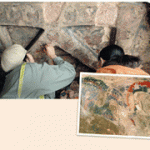 Originally started by physicists of various obscure stripes, job-rumor Web sites now cover more than a dozen disciplines from anthropology to zoology. Some of these Web sites have a Webmaster who (sometimes) vets and posts rumors about postdoc and faculty jobs, whereas other sites take the form of wikis, which individual users can update. The sites offer varying levels of information, but all of them make water-cooler job rumors available to the world.
Originally started by physicists of various obscure stripes, job-rumor Web sites now cover more than a dozen disciplines from anthropology to zoology. Some of these Web sites have a Webmaster who (sometimes) vets and posts rumors about postdoc and faculty jobs, whereas other sites take the form of wikis, which individual users can update. The sites offer varying levels of information, but all of them make water-cooler job rumors available to the world.
Category Archives: Formats
Early Oils
 Buddhist artists in Bamiyan, Afghanistan, may have painted with oils centuries before European Renaissance painters developed the technique.
Buddhist artists in Bamiyan, Afghanistan, may have painted with oils centuries before European Renaissance painters developed the technique.
A team led by Marine Cotte at the European Synchrotron Radiation Facility in Grenoble, France, has analyzed tiny samples of paintings sent by a UNESCO conservation team from a site where the Taliban destroyed two giant Buddha statues in 2001. Initial scans with ultraviolet light led researchers to suspect the presence of oil, and “we have confirmed it,” says Cotte. Twelve of 50 murals depicting colorful Buddhas and mythical creatures, painted in caves behind the statue niches, included pigments bound in plant oils. Oil offers “more freedom” to artists, says Cotte, as it doesn’t set instantly like the gypsum or calcium salt pigments also used in the caves.
Helen Howard of the National Gallery in London says European oil paintings date back to the 12th century, but whether oil was used earlier isn’t known because “analysis hasn’t often been carried out on very early paintings.” UNESCO team leader Yoko Taniguchi of the National Research Institute for Cultural Properties in Tokyo said in a statement that ancient Romans and Egyptians were known to use drying oils, but only as medicines and cosmetics. Thus, the team writes in April’s Journal of Analytical Atomic Spectrometry, the Afghan samples could be the “oldest example of oil paintings on Earth.”
Originally appeared in Science Magazine as a Random Sample: [html] [pdf]
Smokers’ Choice
 Smokers tend to resist antismoking efforts that rely on “rational” approaches such as taxes, and researchers have pointed to confounding influences, including social factors and addiction. But differences in smokers’ decision-making processes may also be at play.
Smokers tend to resist antismoking efforts that rely on “rational” approaches such as taxes, and researchers have pointed to confounding influences, including social factors and addiction. But differences in smokers’ decision-making processes may also be at play.
A recent study from the Baylor College of Medicine found that smokers and nonsmokers react differently to news of how much they could have made in a stock-market game. The feedback was purely incidental: it offered no financial incentive to adjust one’s investment strategy, yet nonsmokers were swayed by what might have been and changed their tactics. Smokers ignored the input, even though they processed the information in the same part of the brain as their nonsmoking peers did.
The study does not address whether smokers’ behavior is a cause or effect of their addiction but rather it adds to the growing list of ways in which human beings sometimes ignore reason when it comes to decision-making. In the book Predictably Irrational (HarperCollins, 2008) behavioral economist Dan Ariely of the Massachusetts Institute of Technology catalogues a bevy of errors, biases and otherwise illogical human behavior. Other behavioral economists are doing the same on the premise that these absurdities are understandable, and they are just beginning to team up with neuroscientists to try to tease out the roots of decision-making biases in the brain.
The hope is that this knowledge will one day inform policy. To combat smoking, for example, policymakers could “use evidence of what brain areas are active during the [decision-making] process to design other strategies” more nuanced than taxation, says behavioral economist Colin Camerer of the California Institute of Technology.
The field of neuroeconomics is in its infancy, however. Neuroeconomists agree with behavioral economists that in the future it will be possible to use our irrationalities to our advantage, but as for whether their work could soon steer policy, “I think it’s just too early” to make a decision, Ariely says.
First published by Scientific American MIND: [html] [pdf].
Young Swedish Scientist Reveals Fast-Track Career Secrets

Thomas Helleday was precocious long before he started supervising Ph.D. students as he finished his own doctorate. His mother, a banker, bought him his first stock at age 7. At age 16, the Swedish native volunteered in a cancer ward with his older brother and “was terrified” by the harsh side effects of radiation therapy he saw there. Vowing to do something about it, potentially in the pharmaceutical industry, Helleday studied business and molecular biology as an undergraduate.
Continue reading Young Swedish Scientist Reveals Fast-Track Career Secrets